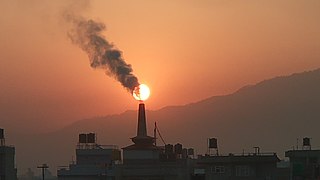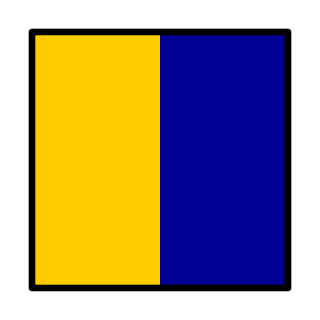Related Research Articles

The International Maritime Organization is a specialised agency of the United Nations responsible for regulating shipping. The IMO was established following agreement at a UN conference held in Geneva in 1948 and the IMO came into existence ten years later, meeting for the first time in 17 March 1958. Headquartered in London, United Kingdom, IMO currently has 175 Member States and three Associate Members.

SOS is a Morse code distress signal, used internationally, originally established for maritime use. In formal notation SOS is written with an overscore line, to indicate that the Morse code equivalents for the individual letters of "SOS" are transmitted as an unbroken sequence of three dots / three dashes / three dots, with no spaces between the letters. In International Morse Code three dots form the letter "S" and three dashes make the letter "O", so "S O S" became a common way to remember the order of the dots and dashes. IWB, VZE, 3B, and V7 form equivalent sequences, but traditionally SOS is the easiest to remember.)

The International Convention for the Prevention of Pollution from Ships, 1973 as modified by the Protocol of 1978, or "MARPOL 73/78" is one of the most important international marine environmental conventions. It was developed by the International Maritime Organization with an objective to minimize pollution of the oceans and seas, including dumping, oil and air pollution.

Marine VHF radio is a worldwide system of two way radio transceivers on ships and watercraft used for bidirectional voice communication from ship-to-ship, ship-to-shore, and in certain circumstances ship-to-aircraft. It uses FM channels in the very high frequency (VHF) radio band in the frequency range between 156 and 174 MHz, inclusive, designated by the International Telecommunication Union as the VHF maritime mobile band. In some countries additional channels are used, such as the L and F channels for leisure and fishing vessels in the Nordic countries. Transmitter power is limited to 25 watts, giving them a range of about 100 kilometres.
The Global Maritime Distress and Safety System (GMDSS) is a worldwide system for automated emergency signal communication for ships at sea developed by the United Nations' International Maritime Organization (IMO) as part of the SOLAS Convention.
The International Convention for the Safety of Life at Sea (SOLAS) is an international maritime treaty that sets minimum safety standards in the construction, equipment and operation of merchant ships. The International Maritime Organization convention requires signatory flag states to ensure that ships flagged by them comply with at least these standards.

The automatic identification system (AIS) is an automatic tracking system that uses transceivers on ships and is used by vessel traffic services (VTS). When satellites are used to receive AIS signatures, the term Satellite-AIS (S-AIS) is used. AIS information supplements marine radar, which continues to be the primary method of collision avoidance for water transport. Although technically and operationally distinct, the ADS-B system is analogous to AIS and performs a similar function for aircraft.

The International Code of Signals (INTERCO) is an international system of signals and codes for use by vessels to communicate important messages regarding safety of navigation and related matters. Signals can be sent by flaghoist, signal lamp ("blinker"), flag semaphore, radiotelegraphy, and radiotelephony. The International Code is the most recent evolution of a wide variety of maritime flag signalling systems.

Seaspeak is a controlled natural language (CNL) based on English, designed to facilitate communication between ships whose captains' native tongues differ. It has now been formalised as Standard Marine Communication Phrases (SMCP).
The International Association of Classification Societies (IACS) is a technically based non-governmental organization that currently consists of eleven member marine classification societies. More than 90% of the world's cargo-carrying ships’ tonnage is covered by the classification standards set by member societies of IACS.

A wiper is a position responsible for both cleaning the engine spaces and machinery of a ship and assisting the ship's engineers as directed. Railroad workers who performed similar jobs were also known as wipers, or in the UK as "cleaners".
Procedure words are words or phrases limited to radio telephone procedure used to facilitate communication by conveying information in a condensed standard verbal format. Prowords are voice versions of the much older procedural signs for Morse code which were first developed in the 1860s for Morse telegraphy, and their meaning is identical.

Ice class refers to a notation assigned by a classification society or a national authority to denote the additional level of strengthening as well as other arrangements that enable a ship to navigate through sea ice. Some ice classes also have requirements for the ice-going performance of the vessel.
Sector Commander is the position title of the commanding officer of a United States Coast Guard Sector, usually of the rank of Captain (O-6). The Sector Commander's second-in-command is the Deputy Sector Commander. Also reporting directly to the Sector Commander are the Command Master Chief (CMC), the Senior Reserve Officer, and the Sector's Auxiliary Coordinator.
MarTEL is a standardised test of maritime English language proficiency, through an interactive online learning platform. It was created under the European Union's Leonardo da Vinci funding stream, in combination with the Lifelong Learning Programme, and was established in 2007.

The environmental effects of shipping include air pollution, water pollution, acoustic, and oil pollution. Ships are responsible for more than 18% of nitrogen oxides pollution, and 3% of greenhouse gas emissions.
e-Navigation is a strategy developed by the International Maritime Organization (IMO), a UN specialized agency, to bring about increased safety of navigation in commercial shipping through better organization of data on ships and on shore, and better data exchange and communication between ships and the ship and shore. The concept was launched when maritime authorities from seven nations requested the IMO's Maritime Safety Committee to add the development of an e-navigation strategy to the work programs of the IMO's NAV and COMSAR sub-committees. Working groups in three sub-committees and an intersessional correspondence group, led by Norway, has subsequently developed a Strategy Implementation Plan (SIP). Member states of IMO and a number of Intergovernmental and non-governmental organisations have contributed to the work, including the International Hydrographic Organization (IHO), Comité International Radio-Maritime (CIRM), the International Association of Lighthouse Authorities (IALA), the International Chamber of Shipping (ICS), the Baltic and International Maritime Council (BIMCO) and the International Electrotechnical Commission (IEC)
International Convention on Oil Pollution Preparedness, Response and Co-operation (OPRC) is an international maritime convention establishing measures for dealing with marine oil pollution incidents nationally and in co-operation with other countries. As of November 2018, there are 112 state parties to the convention.
The International Code for Ships Operating in Polar Waters or Polar Code is an international regime adopted by the International Maritime Organization (IMO) in 2014. The Code sets out regulations for shipping in the polar regions, principally relating to ice navigation and ship design. The international framework aims to protect the two polar regions — the Arctic and Antarctic, from maritime risks. The Code entered into force on 1 January 2017.

The International Convention for the Control and Management of Ships' Ballast Water and Sediments is a 2004 international maritime treaty which requires signatory flag states to ensure that ships flagged by them comply with standards and procedures for the management and control of ships' ballast water and sediments. The Convention aims to prevent the spread of harmful aquatic organisms from one region to another and halt damage to the marine environment from ballast water discharge, by minimising the uptake and subsequent discharge of sediments and organisms. From 2024, all ships are required to have approved Ballast Water Management Treatment System, according to the D2 standard. Existing ships are required to install an approved system, which may cost up to 5 million USD per ship to install. To assist with implementation, the IMO has released 14 Guidance documents in regards to the Convention including the G2 Guidelines for Ballast Water Sampling, G4 Guidelines for Ballast Water management and G6 Guidelines for Ballast Water Exchange. As of 15 July 2021, 86 countries were contracting States to the BWM Convention.
References
- 1 2 "IMO Standard Marine Communication Phrases". Archived from the original on 16 March 2015.
- 1 2 3 4 "Shipboard English for Japanese Pilots" (PDF). Archived from the original (PDF) on 7 October 2021.